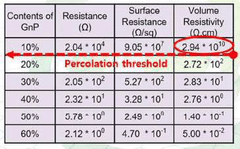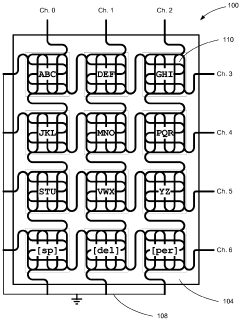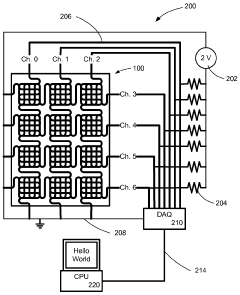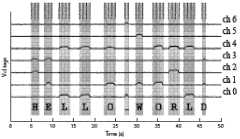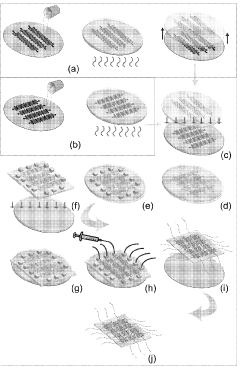Silicone Rubber in the Expansion of Wearable Sensors
JUL 8, 202510 MIN READ
Generate Your Research Report Instantly with AI Agent
Patsnap Eureka helps you evaluate technical feasibility & market potential.
Silicone Rubber in Wearable Sensors: Background and Objectives
Silicone rubber has emerged as a pivotal material in the rapidly evolving field of wearable sensors. Its unique properties, including flexibility, biocompatibility, and durability, have positioned it at the forefront of wearable technology development. The journey of silicone rubber in this domain began in the late 20th century, with initial applications in medical devices and prosthetics. As the demand for more sophisticated and comfortable wearable devices grew, researchers and engineers recognized the potential of silicone rubber to address the limitations of rigid and semi-flexible materials.
The evolution of silicone rubber in wearable sensors has been driven by the increasing need for devices that can seamlessly integrate with the human body. This material's ability to conform to various body shapes and withstand repeated deformation without losing its properties makes it ideal for continuous health monitoring and human-machine interface applications. The technological progression has seen silicone rubber transition from simple protective coatings to complex, functionalized matrices capable of housing advanced sensing elements.
Recent years have witnessed a surge in research focused on enhancing the properties of silicone rubber for wearable sensor applications. Scientists are exploring ways to improve its electrical conductivity, sensitivity to various stimuli, and integration with other materials to create hybrid systems. The goal is to develop sensors that can detect a wide range of physiological parameters with high accuracy while maintaining the comfort and unobtrusiveness that users demand.
The objectives of current research on silicone rubber in wearable sensors are multifaceted. Primarily, there is a push to develop sensors with improved stretchability and sensitivity, capable of detecting subtle changes in pressure, temperature, and biochemical markers. Another key aim is to enhance the durability and longevity of these sensors, ensuring they can withstand the rigors of daily wear and environmental factors.
Furthermore, researchers are working on integrating silicone rubber-based sensors with advanced data processing and wireless communication technologies. This integration is crucial for real-time health monitoring and the development of closed-loop systems that can respond to physiological changes automatically. The ultimate vision is to create a new generation of wearable devices that are not only highly functional but also comfortable, durable, and seamlessly integrated into users' lives.
As we look to the future, the potential applications of silicone rubber in wearable sensors continue to expand. From healthcare and fitness tracking to virtual reality interfaces and smart textiles, the versatility of this material promises to revolutionize how we interact with technology and monitor our health. The ongoing research aims to unlock new possibilities, pushing the boundaries of what is achievable in wearable technology and bringing us closer to a world where our devices are truly extensions of ourselves.
The evolution of silicone rubber in wearable sensors has been driven by the increasing need for devices that can seamlessly integrate with the human body. This material's ability to conform to various body shapes and withstand repeated deformation without losing its properties makes it ideal for continuous health monitoring and human-machine interface applications. The technological progression has seen silicone rubber transition from simple protective coatings to complex, functionalized matrices capable of housing advanced sensing elements.
Recent years have witnessed a surge in research focused on enhancing the properties of silicone rubber for wearable sensor applications. Scientists are exploring ways to improve its electrical conductivity, sensitivity to various stimuli, and integration with other materials to create hybrid systems. The goal is to develop sensors that can detect a wide range of physiological parameters with high accuracy while maintaining the comfort and unobtrusiveness that users demand.
The objectives of current research on silicone rubber in wearable sensors are multifaceted. Primarily, there is a push to develop sensors with improved stretchability and sensitivity, capable of detecting subtle changes in pressure, temperature, and biochemical markers. Another key aim is to enhance the durability and longevity of these sensors, ensuring they can withstand the rigors of daily wear and environmental factors.
Furthermore, researchers are working on integrating silicone rubber-based sensors with advanced data processing and wireless communication technologies. This integration is crucial for real-time health monitoring and the development of closed-loop systems that can respond to physiological changes automatically. The ultimate vision is to create a new generation of wearable devices that are not only highly functional but also comfortable, durable, and seamlessly integrated into users' lives.
As we look to the future, the potential applications of silicone rubber in wearable sensors continue to expand. From healthcare and fitness tracking to virtual reality interfaces and smart textiles, the versatility of this material promises to revolutionize how we interact with technology and monitor our health. The ongoing research aims to unlock new possibilities, pushing the boundaries of what is achievable in wearable technology and bringing us closer to a world where our devices are truly extensions of ourselves.
Market Analysis for Silicone-Based Wearable Sensors
The market for silicone-based wearable sensors is experiencing rapid growth, driven by increasing demand for health monitoring devices and advancements in flexible electronics. This segment of the wearable technology market is particularly promising due to the unique properties of silicone rubber, which offer comfort, durability, and biocompatibility.
The global wearable sensors market is projected to reach significant value in the coming years, with silicone-based sensors playing a crucial role. Key factors contributing to this growth include rising health awareness, an aging population, and the increasing prevalence of chronic diseases that require continuous monitoring.
Consumer electronics and healthcare sectors are the primary drivers of demand for silicone-based wearable sensors. In the consumer electronics market, fitness trackers and smartwatches incorporating these sensors have gained substantial popularity. The healthcare sector is adopting wearable sensors for remote patient monitoring, early disease detection, and personalized medicine applications.
The sports and fitness industry also presents a substantial market opportunity for silicone-based wearable sensors. Athletes and fitness enthusiasts are increasingly using these devices to track performance metrics, optimize training, and prevent injuries.
Geographically, North America and Europe currently lead the market due to high adoption rates of wearable technology and advanced healthcare infrastructure. However, the Asia-Pacific region is expected to witness the fastest growth, driven by increasing disposable income, growing health awareness, and rapid technological advancements in countries like China and India.
Key market trends include the integration of artificial intelligence and machine learning capabilities in wearable devices, enabling more accurate data analysis and personalized insights. There is also a growing focus on developing multi-functional sensors that can measure multiple parameters simultaneously, enhancing the overall value proposition for consumers.
Challenges in the market include concerns over data privacy and security, as well as the need for improved battery life and power efficiency in wearable devices. Additionally, there is a growing demand for more accurate and reliable sensors, particularly for medical-grade applications.
The competitive landscape is characterized by a mix of established technology giants and innovative startups. Major players are investing heavily in research and development to improve sensor accuracy, reduce form factors, and enhance overall performance. Collaborations between technology companies and healthcare providers are becoming increasingly common, aiming to develop specialized wearable solutions for specific medical conditions.
The global wearable sensors market is projected to reach significant value in the coming years, with silicone-based sensors playing a crucial role. Key factors contributing to this growth include rising health awareness, an aging population, and the increasing prevalence of chronic diseases that require continuous monitoring.
Consumer electronics and healthcare sectors are the primary drivers of demand for silicone-based wearable sensors. In the consumer electronics market, fitness trackers and smartwatches incorporating these sensors have gained substantial popularity. The healthcare sector is adopting wearable sensors for remote patient monitoring, early disease detection, and personalized medicine applications.
The sports and fitness industry also presents a substantial market opportunity for silicone-based wearable sensors. Athletes and fitness enthusiasts are increasingly using these devices to track performance metrics, optimize training, and prevent injuries.
Geographically, North America and Europe currently lead the market due to high adoption rates of wearable technology and advanced healthcare infrastructure. However, the Asia-Pacific region is expected to witness the fastest growth, driven by increasing disposable income, growing health awareness, and rapid technological advancements in countries like China and India.
Key market trends include the integration of artificial intelligence and machine learning capabilities in wearable devices, enabling more accurate data analysis and personalized insights. There is also a growing focus on developing multi-functional sensors that can measure multiple parameters simultaneously, enhancing the overall value proposition for consumers.
Challenges in the market include concerns over data privacy and security, as well as the need for improved battery life and power efficiency in wearable devices. Additionally, there is a growing demand for more accurate and reliable sensors, particularly for medical-grade applications.
The competitive landscape is characterized by a mix of established technology giants and innovative startups. Major players are investing heavily in research and development to improve sensor accuracy, reduce form factors, and enhance overall performance. Collaborations between technology companies and healthcare providers are becoming increasingly common, aiming to develop specialized wearable solutions for specific medical conditions.
Current Challenges in Silicone Rubber Wearable Sensor Technology
The field of silicone rubber wearable sensors faces several significant challenges that hinder its widespread adoption and technological advancement. One of the primary obstacles is the trade-off between flexibility and sensitivity. While silicone rubber offers excellent flexibility and conformability to the human body, enhancing its sensitivity without compromising these properties remains a complex task. Researchers are grappling with the need to develop sensors that can accurately detect minute changes in pressure, strain, or temperature while maintaining the elasticity and comfort that make silicone rubber an attractive material for wearable applications.
Another critical challenge lies in the long-term stability and durability of silicone rubber sensors. Continuous exposure to environmental factors such as sweat, temperature fluctuations, and mechanical stress can lead to degradation of sensor performance over time. This issue is particularly pronounced in applications requiring prolonged wear, such as health monitoring devices or sports performance trackers. Developing robust encapsulation methods and improving the chemical stability of silicone rubber composites are areas of ongoing research to address this challenge.
The integration of silicone rubber sensors with rigid electronic components presents another hurdle. While the sensors themselves can be highly flexible, connecting them to traditional circuit boards and power sources often introduces points of rigidity and potential failure. This integration challenge extends to data transmission systems, where maintaining reliable connections between soft sensors and hard electronics remains problematic. Innovative approaches to flexible electronics and wireless communication are being explored to overcome these limitations.
Manufacturability and scalability pose additional challenges in the commercialization of silicone rubber wearable sensors. Current fabrication methods often involve complex, multi-step processes that are difficult to scale up for mass production. Developing streamlined manufacturing techniques that can produce consistent, high-quality sensors at a competitive cost is crucial for market viability. This includes addressing issues related to material uniformity, sensor calibration, and quality control in large-scale production environments.
Biocompatibility and user comfort remain ongoing concerns, particularly for long-term wear applications. While silicone rubber is generally considered safe for skin contact, prolonged use can lead to skin irritation or allergic reactions in some individuals. Researchers are working on developing hypoallergenic formulations and exploring surface modification techniques to enhance biocompatibility without compromising sensor performance.
Lastly, the challenge of power management in silicone rubber wearable sensors cannot be overlooked. Many current designs rely on external power sources or bulky batteries that detract from the overall flexibility and wearability of the device. Developing efficient, flexible, and potentially self-powered sensor systems is a key area of research, with efforts focused on energy harvesting technologies and low-power sensor designs to enable truly autonomous wearable devices.
Another critical challenge lies in the long-term stability and durability of silicone rubber sensors. Continuous exposure to environmental factors such as sweat, temperature fluctuations, and mechanical stress can lead to degradation of sensor performance over time. This issue is particularly pronounced in applications requiring prolonged wear, such as health monitoring devices or sports performance trackers. Developing robust encapsulation methods and improving the chemical stability of silicone rubber composites are areas of ongoing research to address this challenge.
The integration of silicone rubber sensors with rigid electronic components presents another hurdle. While the sensors themselves can be highly flexible, connecting them to traditional circuit boards and power sources often introduces points of rigidity and potential failure. This integration challenge extends to data transmission systems, where maintaining reliable connections between soft sensors and hard electronics remains problematic. Innovative approaches to flexible electronics and wireless communication are being explored to overcome these limitations.
Manufacturability and scalability pose additional challenges in the commercialization of silicone rubber wearable sensors. Current fabrication methods often involve complex, multi-step processes that are difficult to scale up for mass production. Developing streamlined manufacturing techniques that can produce consistent, high-quality sensors at a competitive cost is crucial for market viability. This includes addressing issues related to material uniformity, sensor calibration, and quality control in large-scale production environments.
Biocompatibility and user comfort remain ongoing concerns, particularly for long-term wear applications. While silicone rubber is generally considered safe for skin contact, prolonged use can lead to skin irritation or allergic reactions in some individuals. Researchers are working on developing hypoallergenic formulations and exploring surface modification techniques to enhance biocompatibility without compromising sensor performance.
Lastly, the challenge of power management in silicone rubber wearable sensors cannot be overlooked. Many current designs rely on external power sources or bulky batteries that detract from the overall flexibility and wearability of the device. Developing efficient, flexible, and potentially self-powered sensor systems is a key area of research, with efforts focused on energy harvesting technologies and low-power sensor designs to enable truly autonomous wearable devices.
Existing Silicone Rubber Solutions for Wearable Sensors
01 Composition and formulation of silicone rubber
Silicone rubber compositions typically include a base polymer, curing agents, and various additives. The formulation can be adjusted to achieve specific properties such as heat resistance, electrical insulation, or flexibility. Different types of silicone polymers and curing systems can be used to tailor the rubber for specific applications.- Composition and preparation of silicone rubber: Silicone rubber is typically composed of silicone polymers, fillers, and curing agents. The preparation process often involves mixing these components, shaping the mixture, and then curing it to form the final rubber product. Various additives can be incorporated to enhance specific properties such as strength, flexibility, or heat resistance.
- Modification of silicone rubber properties: The properties of silicone rubber can be modified through the addition of specific compounds or by altering the polymer structure. This can include improving mechanical strength, increasing thermal stability, enhancing electrical properties, or adjusting the rubber's hardness or elasticity to suit specific applications.
- Silicone rubber in medical and healthcare applications: Silicone rubber is widely used in medical and healthcare products due to its biocompatibility, flexibility, and durability. Applications include medical devices, implants, prosthetics, and drug delivery systems. Special formulations may be developed to meet specific medical requirements such as antimicrobial properties or controlled drug release.
- Silicone rubber in electronic and electrical applications: Silicone rubber finds extensive use in electronic and electrical applications due to its excellent insulating properties and resistance to extreme temperatures. It is used in the production of cables, connectors, seals, and various components in electronic devices. Specialized formulations may be developed to enhance specific electrical or thermal properties.
- Environmental and sustainability aspects of silicone rubber: Research and development efforts are focused on improving the environmental profile of silicone rubber. This includes developing bio-based silicone materials, improving recycling methods, and reducing the environmental impact of production processes. Additionally, the long lifespan and durability of silicone rubber contribute to its sustainability in various applications.
02 Manufacturing processes for silicone rubber products
Various manufacturing techniques are employed to produce silicone rubber products, including molding, extrusion, and calendering. These processes often involve precise control of temperature, pressure, and curing conditions to achieve desired product characteristics. Advanced manufacturing methods may incorporate automation and specialized equipment for improved efficiency and consistency.Expand Specific Solutions03 Modification and enhancement of silicone rubber properties
Silicone rubber properties can be modified through the incorporation of fillers, reinforcing agents, or chemical modifications. These enhancements can improve mechanical strength, thermal stability, or introduce specific functionalities such as flame retardancy or conductivity. Researchers continue to develop novel additives and modification techniques to expand the application range of silicone rubber.Expand Specific Solutions04 Applications of silicone rubber in various industries
Silicone rubber finds widespread use across multiple industries due to its unique properties. It is commonly used in medical devices, automotive components, electrical insulation, consumer products, and aerospace applications. The material's biocompatibility, durability, and resistance to extreme temperatures make it suitable for diverse and demanding environments.Expand Specific Solutions05 Environmental considerations and sustainability of silicone rubber
Research is ongoing to improve the environmental profile of silicone rubber, including the development of bio-based alternatives and recycling methods. Efforts are being made to reduce the carbon footprint of production processes and enhance the material's end-of-life management. Some studies focus on creating more sustainable silicone rubber formulations without compromising performance.Expand Specific Solutions
Key Players in Silicone Rubber Wearable Sensor Industry
The research on silicone rubber in wearable sensors is in a growth phase, with increasing market size and technological advancements. The global wearable sensors market is expanding rapidly, driven by rising demand for health monitoring devices. Technologically, silicone rubber applications are progressing from basic to more sophisticated implementations. Key players like Shin-Etsu Chemical, Momentive Performance Materials, and Wacker Chemie are leading innovation in silicone materials for wearable sensors. Universities such as Harvard, Yale, and the National University of Singapore are contributing to fundamental research, while companies like Apple and Fitbit are integrating these advancements into consumer products, indicating a maturing ecosystem spanning academia and industry.
Shin-Etsu Chemical Co., Ltd.
Technical Solution: Shin-Etsu Chemical has developed advanced silicone rubber compounds specifically tailored for wearable sensor applications. Their technology focuses on enhancing the elasticity and durability of silicone rubber to withstand repeated stretching and bending in wearable devices. The company has introduced a range of silicone elastomers with improved electrical conductivity, allowing for more sensitive and accurate sensor readings[1]. Their latest formulations also incorporate self-healing properties, enabling the material to recover from minor damage and extend the lifespan of wearable sensors[3]. Shin-Etsu's silicone rubber compounds are designed to maintain stable performance across a wide temperature range, making them suitable for various environmental conditions[5].
Strengths: Industry-leading expertise in silicone materials, wide range of specialized formulations, and strong R&D capabilities. Weaknesses: Higher cost compared to some alternatives, potential limitations in extreme environments.
Momentive Performance Materials, Inc.
Technical Solution: Momentive has developed a series of silicone elastomers specifically designed for wearable sensor applications. Their technology focuses on creating ultra-thin, highly flexible silicone films that can conform to complex body contours while maintaining excellent electrical properties. The company's silicone rubber formulations incorporate advanced additives to enhance biocompatibility and reduce skin irritation, making them ideal for long-term wear[2]. Momentive has also introduced self-adhesive silicone elastomers that can be directly applied to the skin without additional adhesives, simplifying the manufacturing process of wearable sensors[4]. Their latest innovations include silicone composites with improved thermal management properties, addressing the heat dissipation challenges in compact wearable devices[6].
Strengths: Specialized formulations for wearable applications, excellent conformability, and strong focus on user comfort. Weaknesses: May have limited options for high-performance applications requiring extreme durability.
Innovative Silicone Rubber Formulations for Wearables
A carbon-type rubber complex and a method for preparing the same
PatentPendingKR1020220082956A
Innovation
- A carbon-based rubber composite comprising 11 to 95% bromo isobutylene isoprene rubber and 0.1 to 10% graphene nanoplates, produced through a high-temperature extrusion process, achieving high conductivity and insulation.
Wearable tactile keypad with stretchable artificial skin
PatentWO2012050938A2
Innovation
- A thin, flexible elastomeric sheet with embedded conductive liquid microchannels, fabricated using maskless photolithography, which allows for the creation of highly compliant and pressure-sensitive tactile keypads that can conform to various surfaces and detect pressure changes across a larger area, enabling accurate location and intensity sensing.
Biocompatibility and Safety Considerations
The biocompatibility and safety considerations of silicone rubber in wearable sensors are paramount for their successful implementation and widespread adoption. Silicone rubber, known for its flexibility, durability, and chemical inertness, has emerged as a promising material for wearable sensor applications. However, its direct contact with human skin necessitates a thorough evaluation of its biocompatibility and potential health impacts.
Biocompatibility refers to the ability of a material to perform its intended function without eliciting any undesirable local or systemic effects in the recipient. In the context of wearable sensors, silicone rubber must demonstrate excellent biocompatibility to ensure user safety and comfort during prolonged skin contact. Studies have shown that medical-grade silicone rubber generally exhibits good biocompatibility, with minimal risk of allergic reactions or skin irritation.
The safety profile of silicone rubber in wearable sensors encompasses several key aspects. Firstly, the material's chemical stability is crucial to prevent leaching of potentially harmful substances into the skin. Silicone rubber's resistance to degradation under various environmental conditions, including exposure to sweat, UV radiation, and temperature fluctuations, contributes to its safety profile. Additionally, its low toxicity and non-reactivity with biological tissues further enhance its suitability for wearable applications.
However, certain considerations must be addressed to ensure the long-term safety of silicone rubber in wearable sensors. The potential for microbial growth on the sensor surface is a concern, as it may lead to skin infections or other health issues. Incorporating antimicrobial properties into the silicone rubber formulation or applying antimicrobial coatings can mitigate this risk. Furthermore, the accumulation of dead skin cells, sweat, and other debris on the sensor surface may affect its performance and hygiene, necessitating regular cleaning and maintenance protocols.
The manufacturing process of silicone rubber-based wearable sensors also plays a crucial role in ensuring biocompatibility and safety. Strict quality control measures must be implemented to prevent contamination and ensure consistent material properties. The use of medical-grade silicone rubber and adherence to relevant regulatory standards, such as ISO 10993 for biocompatibility testing, are essential for meeting safety requirements.
Long-term studies on the effects of prolonged skin contact with silicone rubber in wearable sensors are ongoing. While initial results are promising, continued research is necessary to fully understand any potential long-term impacts on skin health, allergic sensitization, or systemic effects. As wearable sensor technology advances, the development of novel silicone rubber formulations with enhanced biocompatibility and safety features will likely contribute to the expansion of this field.
Biocompatibility refers to the ability of a material to perform its intended function without eliciting any undesirable local or systemic effects in the recipient. In the context of wearable sensors, silicone rubber must demonstrate excellent biocompatibility to ensure user safety and comfort during prolonged skin contact. Studies have shown that medical-grade silicone rubber generally exhibits good biocompatibility, with minimal risk of allergic reactions or skin irritation.
The safety profile of silicone rubber in wearable sensors encompasses several key aspects. Firstly, the material's chemical stability is crucial to prevent leaching of potentially harmful substances into the skin. Silicone rubber's resistance to degradation under various environmental conditions, including exposure to sweat, UV radiation, and temperature fluctuations, contributes to its safety profile. Additionally, its low toxicity and non-reactivity with biological tissues further enhance its suitability for wearable applications.
However, certain considerations must be addressed to ensure the long-term safety of silicone rubber in wearable sensors. The potential for microbial growth on the sensor surface is a concern, as it may lead to skin infections or other health issues. Incorporating antimicrobial properties into the silicone rubber formulation or applying antimicrobial coatings can mitigate this risk. Furthermore, the accumulation of dead skin cells, sweat, and other debris on the sensor surface may affect its performance and hygiene, necessitating regular cleaning and maintenance protocols.
The manufacturing process of silicone rubber-based wearable sensors also plays a crucial role in ensuring biocompatibility and safety. Strict quality control measures must be implemented to prevent contamination and ensure consistent material properties. The use of medical-grade silicone rubber and adherence to relevant regulatory standards, such as ISO 10993 for biocompatibility testing, are essential for meeting safety requirements.
Long-term studies on the effects of prolonged skin contact with silicone rubber in wearable sensors are ongoing. While initial results are promising, continued research is necessary to fully understand any potential long-term impacts on skin health, allergic sensitization, or systemic effects. As wearable sensor technology advances, the development of novel silicone rubber formulations with enhanced biocompatibility and safety features will likely contribute to the expansion of this field.
Environmental Impact and Sustainability of Silicone Wearables
The increasing adoption of silicone rubber in wearable sensors raises important questions about environmental impact and sustainability. Silicone rubber, while offering excellent properties for wearable applications, presents both challenges and opportunities in terms of ecological considerations.
Silicone rubber production primarily relies on silicon, oxygen, and carbon, which are abundant elements. However, the manufacturing process involves energy-intensive steps and the use of potentially harmful chemicals. The environmental footprint of silicone rubber production includes greenhouse gas emissions, water consumption, and the generation of hazardous waste. As the demand for wearable sensors grows, addressing these production-related environmental concerns becomes increasingly crucial.
One of the key advantages of silicone rubber in terms of sustainability is its durability and long lifespan. Wearable sensors made with silicone rubber tend to have extended operational lives, reducing the frequency of replacement and, consequently, the overall environmental impact associated with manufacturing and disposal. This longevity aligns well with the principles of sustainable product design and contributes to reducing electronic waste.
The end-of-life management of silicone wearables presents both challenges and opportunities. While silicone rubber is not biodegradable, it can be recycled through specialized processes. However, the complex nature of wearable devices, which often integrate silicone with other materials and electronic components, complicates recycling efforts. Developing effective recycling technologies and establishing comprehensive collection systems for used wearables are critical steps towards improving the sustainability of silicone-based sensors.
Innovations in green chemistry and sustainable manufacturing practices offer promising avenues for reducing the environmental impact of silicone rubber production. Research into bio-based alternatives and environmentally friendly catalysts could lead to more sustainable silicone materials. Additionally, advancements in energy-efficient production methods and closed-loop manufacturing systems have the potential to significantly decrease the carbon footprint of silicone wearables.
The biocompatibility of silicone rubber, while primarily a benefit for user safety, also has positive implications for environmental impact. The material's low toxicity and chemical inertness reduce the risk of harmful substances leaching into the environment during use or disposal. This characteristic is particularly important for wearable sensors that may come into contact with water or soil at the end of their lifecycle.
As the wearable sensor market expands, there is a growing emphasis on incorporating sustainability principles into product design. This includes exploring modular designs that facilitate easier repair and component replacement, as well as developing sensors with biodegradable or easily recyclable components wherever possible. Such design innovations, combined with advances in silicone rubber technology, could pave the way for more environmentally friendly wearable devices.
Silicone rubber production primarily relies on silicon, oxygen, and carbon, which are abundant elements. However, the manufacturing process involves energy-intensive steps and the use of potentially harmful chemicals. The environmental footprint of silicone rubber production includes greenhouse gas emissions, water consumption, and the generation of hazardous waste. As the demand for wearable sensors grows, addressing these production-related environmental concerns becomes increasingly crucial.
One of the key advantages of silicone rubber in terms of sustainability is its durability and long lifespan. Wearable sensors made with silicone rubber tend to have extended operational lives, reducing the frequency of replacement and, consequently, the overall environmental impact associated with manufacturing and disposal. This longevity aligns well with the principles of sustainable product design and contributes to reducing electronic waste.
The end-of-life management of silicone wearables presents both challenges and opportunities. While silicone rubber is not biodegradable, it can be recycled through specialized processes. However, the complex nature of wearable devices, which often integrate silicone with other materials and electronic components, complicates recycling efforts. Developing effective recycling technologies and establishing comprehensive collection systems for used wearables are critical steps towards improving the sustainability of silicone-based sensors.
Innovations in green chemistry and sustainable manufacturing practices offer promising avenues for reducing the environmental impact of silicone rubber production. Research into bio-based alternatives and environmentally friendly catalysts could lead to more sustainable silicone materials. Additionally, advancements in energy-efficient production methods and closed-loop manufacturing systems have the potential to significantly decrease the carbon footprint of silicone wearables.
The biocompatibility of silicone rubber, while primarily a benefit for user safety, also has positive implications for environmental impact. The material's low toxicity and chemical inertness reduce the risk of harmful substances leaching into the environment during use or disposal. This characteristic is particularly important for wearable sensors that may come into contact with water or soil at the end of their lifecycle.
As the wearable sensor market expands, there is a growing emphasis on incorporating sustainability principles into product design. This includes exploring modular designs that facilitate easier repair and component replacement, as well as developing sensors with biodegradable or easily recyclable components wherever possible. Such design innovations, combined with advances in silicone rubber technology, could pave the way for more environmentally friendly wearable devices.
Unlock deeper insights with Patsnap Eureka Quick Research — get a full tech report to explore trends and direct your research. Try now!
Generate Your Research Report Instantly with AI Agent
Supercharge your innovation with Patsnap Eureka AI Agent Platform!


